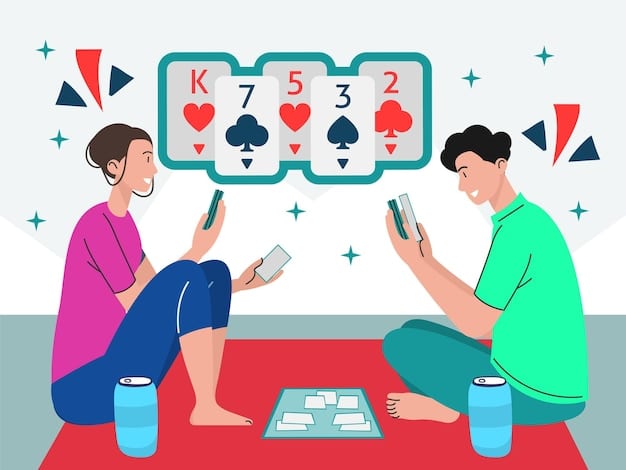Memorize Cards in 5 Minutes: PAO System Guide

Memorizing a deck of cards in under 5 minutes is achievable using the Person-Action-Object (PAO) system, a memory technique that assigns a unique person, action, and object to each card, transforming them into memorable images and stories.
Want to impress your friends or boost your memory skills? Learning how to memorize a deck of cards in under 5 minutes: a step-by-step guide to the PAO system can unlock incredible mental feats. This guide provides a comprehensive approach to mastering this powerful memory technique.
Understanding the Basics of the PAO System
The Person-Action-Object (PAO) system is a mnemonic technique used to memorize sequences, like a deck of cards. It works by converting each card into a memorable image made up of a person, an action, and an object. This structured approach makes recalling the cards faster and more efficient than traditional memorization methods.
Breaking Down the PAO Components
Each element of the PAO system plays a critical role in creating vivid and easily retrievable memories. Understanding these components is the first step to mastering the technique.
- Person: Assigning a specific person to each card (or pair of cards) provides a focal point for your mental image. Choose people you know well or famous figures, making them instantly recognizable.
- Action: The action is what the person is doing in your mental image. It should be dynamic and engaging, helping to solidify the memory. The more unusual or absurd the action, the better it will stick.
- Object: The object is what the person is interacting with. Like the action, the object should be something easily visualized and, ideally, connected to the person or action in some way.
By combining these three elements, you create a unique and memorable story for each card, which can then be linked together to remember the entire sequence of the deck.

Step-by-Step Guide to Creating Your PAO System
Creating your PAO system is a personal process, but following a structured approach can make it easier. Here’s how to build your own system to start memorizing cards quickly.
Assigning People, Actions, and Objects to Each Card
The core of the PAO system is assigning a unique person, action, and object to each card in the deck. This is the most time-consuming part, but it’s essential for effective memorization.
Tips for Making Associations Memorable
The key to a successful PAO system is creating associations that are vivid and easy to recall. Here are some tips to make your PAO system stick:
- Use Vivid Imagery: The more bizarre and unusual your images, the easier they’ll be to remember. Don’t be afraid to get creative and think outside the box.
- Incorporate Emotion: Associating emotions with your images can make them even more memorable. Think about how the person feels while performing the action or interacting with the object.
- Link to Personal Experiences: Connecting your PAO elements to personal experiences or memories can make them more meaningful and easier to recall.
Once you’ve assigned a PAO to each card and practiced visualizing them, you’ll be ready to start memorizing entire decks.
Mastering the Memory Palace Technique
The memory palace, also known as the method of loci, is an ancient mnemonic device that combines visualization with spatial memory to enhance recall. Integrating this technique with the PAO system can significantly boost your card memorization abilities. This involves mentally constructing a familiar location and placing your PAO images along a specific route within that location.
Creating Your Mental Landscape
A memory palace is a mental representation of a physical place that you know well. This could be your home, your walk to work, or any other location you can easily visualize. The key is to choose a place with distinct landmarks or locations that you can use as “memory slots”.
Placing PAO Images Within Your Palace
Once you have your memory palace, it’s time to start placing your PAO images within it. As you visualize each card’s PAO, imagine it interacting with a specific location in your palace. The more vivid and unusual the interaction, the better you’ll remember it.
- Choose a Familiar Location: Select a place you know well, such as your house, a park, or your office. The familiarity will make it easier to navigate mentally.
- Create a Route: Establish a specific route through your location. This will ensure you remember the cards in the correct order.
- Place Images Strategically: Place your PAO images at distinct locations along your route. The more memorable the location, the better.
Using a memory palace can help you organize and recall the sequence of cards more effectively.

Practice Techniques for Speed and Accuracy
Mastering card memorization requires consistent practice and refinement of your PAO system and memory palace. The goal is to increase both your speed and accuracy in recalling the sequence of the deck. Here are some techniques to help you improve your performance.
Regular Training Exercises
Consistent training is key to improving your card memorization skills. Schedule regular practice sessions to reinforce your PAO system and memory palace. Start with short sessions and gradually increase the duration as you become more proficient.
Tips for Reducing Errors
Even with a well-developed PAO system and memory palace, errors can still occur. Here are some tips for reducing errors and improving accuracy:
- Review Your PAO System: Regularly review your PAO assignments to ensure they are still vivid and easy to recall.
- Visualize Clearly: Focus on creating clear and detailed images in your memory palace. The more vivid the images, the less likely you are to make mistakes.
- Take Breaks: If you start to feel mentally fatigued, take a break and come back to your practice session later.
By consistently training and refining your techniques, you can significantly improve your card memorization abilities.
Advanced Strategies for Card Memorization
Once you’ve mastered the basics of the PAO system and memory palace technique, you can explore advanced strategies to further enhance your card memorization abilities. These strategies involve streamlining your system and optimizing your mental processes for maximum speed and accuracy.
Streamlining Your PAO System
As you become more experienced with the PAO system, you may find ways to streamline your assignments and make them even more efficient. This can involve simplifying your actions or choosing people and objects that are more easily associated with the cards.
Optimizing Your Mental Processes
Optimizing your mental processes involves fine-tuning your concentration, visualization, and recall abilities. Here are some advanced techniques to help you improve your mental performance:
- Mindfulness Meditation: Practicing mindfulness meditation can help you improve your focus and concentration, making it easier to visualize and recall your PAO images.
- Speed Visualization: Train yourself to quickly and accurately visualize your PAO images. This can involve using flashcards or other visual aids to speed up the association process.
- Active Recall: Regularly test yourself by actively recalling the sequence of cards without looking at the deck. This will help reinforce your memory and identify any weak spots in your system.
By implementing these advanced strategies, you can take your card memorization skills to the next level and achieve impressive feats of memory.
Troubleshooting Common Challenges
Even with a solid understanding of the PAO system and diligent practice, you may encounter challenges along the way. Recognizing these hurdles and implementing effective solutions is essential for continued progress in card memorization.
Forgetting PAO Assignments
One common challenge is forgetting the PAO assignments for specific cards. This can happen if you don’t review your system regularly or if the associations aren’t strong enough.
Recalling the Incorrect Order
Another challenge is recalling the incorrect order of the cards. This can occur if your memory palace isn’t well-organized or if you don’t visualize the sequence clearly.
- Review Regularly: Make sure to review your PAO assignments and memory palace regularly to reinforce your memory.
- Visualize Vividly: Create clear and detailed images in your memory palace to help you recall the sequence accurately.
- Experiment with Different Locations: If you’re having trouble recalling the order, try using a different memory palace or changing the route within your palace.
By addressing these common challenges, you can overcome obstacles and continue improving your card memorization skills.
| Key Point | Brief Description |
|---|---|
| 👤 PAO System | Assign a Person, Action, and Object to each card. |
| 🏛️ Memory Palace | Use a familiar location to store PAO images in sequence. |
| 💪 Practice | Regular training is crucial for improving speed and accuracy. |
| 🧠 Vivid Imagery | Create bizarre and emotional images for better recall. |
Frequently Asked Questions
▼
The PAO (Person-Action-Object) system is a mnemonic technique used to memorize sequences. It involves assigning a person, an action, and an object to each item in the sequence, creating memorable images.
▼
Creating a PAO system for a deck of cards can take several hours to a few days, depending on your pace. It’s an investment that pays off with improved memorization skills.
▼
While not strictly necessary, the memory palace technique enhances the PAO system by providing a structured spatial framework for organizing and recalling information.
▼
Practice regularly, ideally daily or at least a few times a week. Consistent practice reinforces your PAO assignments and memory palace, leading to faster improvement.
▼
If you forget a PAO assignment, try to reconstruct it based on the card’s value and suit. If that fails, skip it and come back later, or create a temporary association.
Conclusion
By understanding the basics of the PAO system, mastering memory palace techniques, and consistently practicing, you can learn how to memorize a deck of cards in under 5 minutes: a step-by-step guide to the PAO system. This skill enhances memory and offers mental agility.





